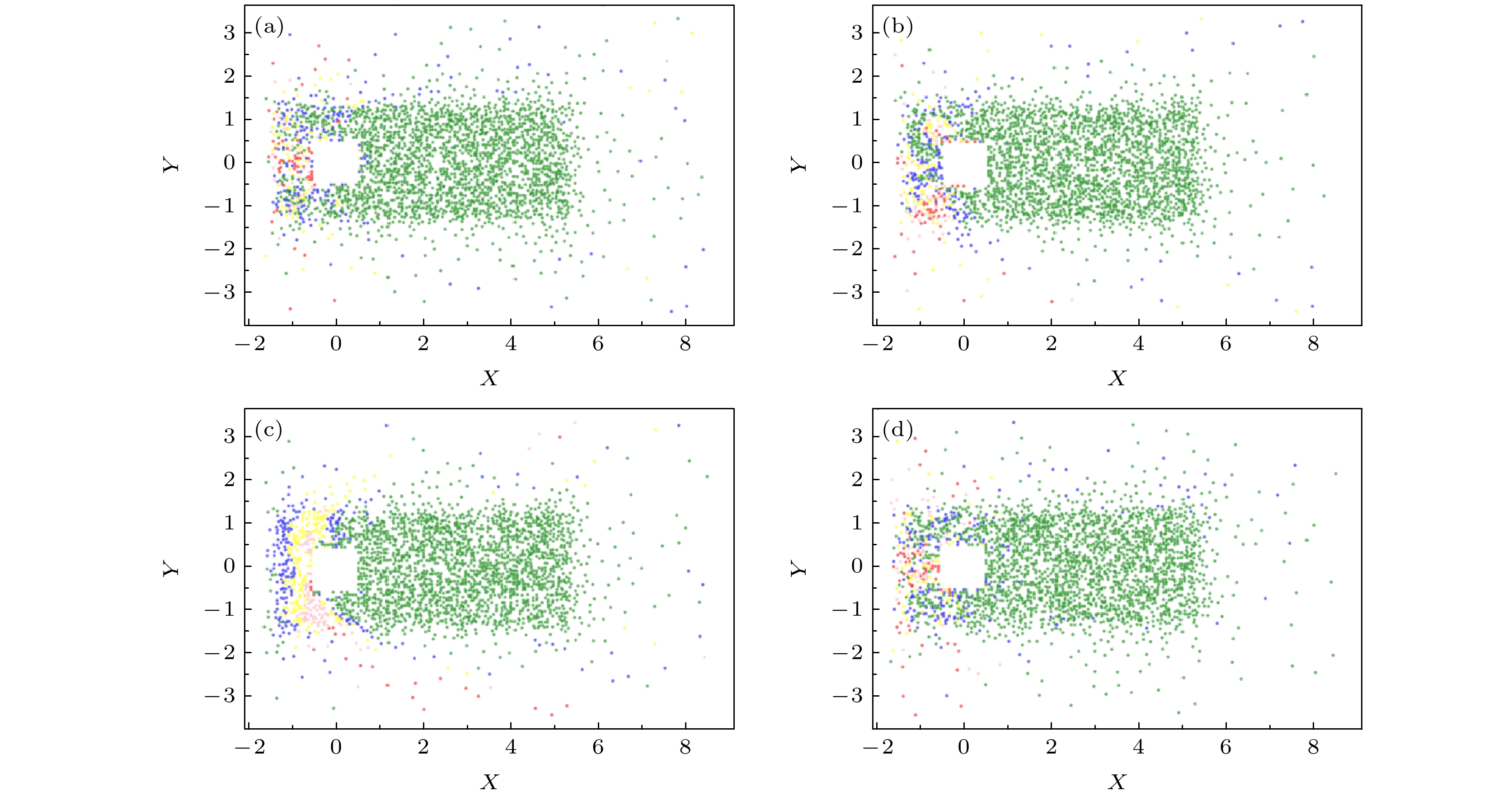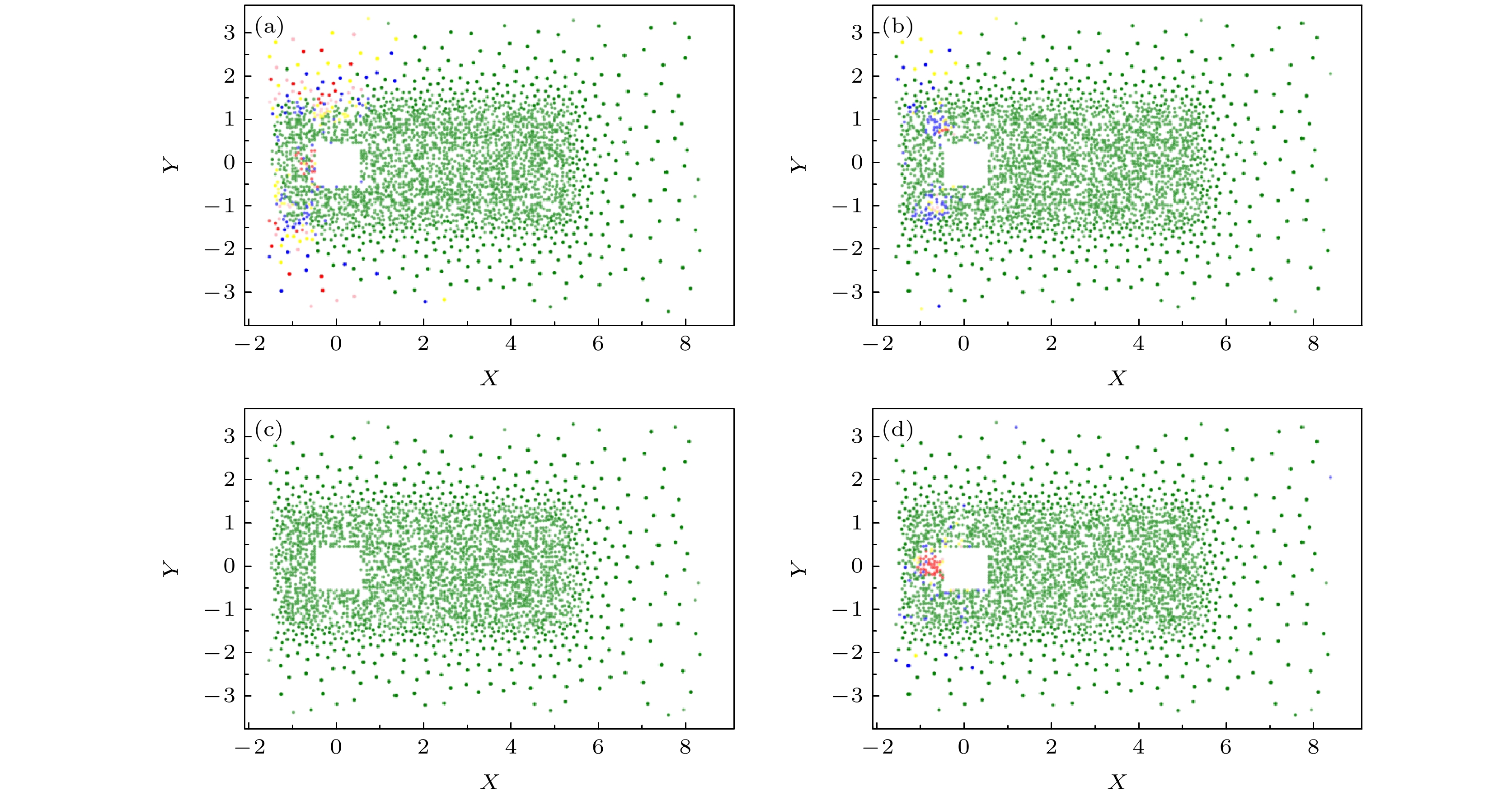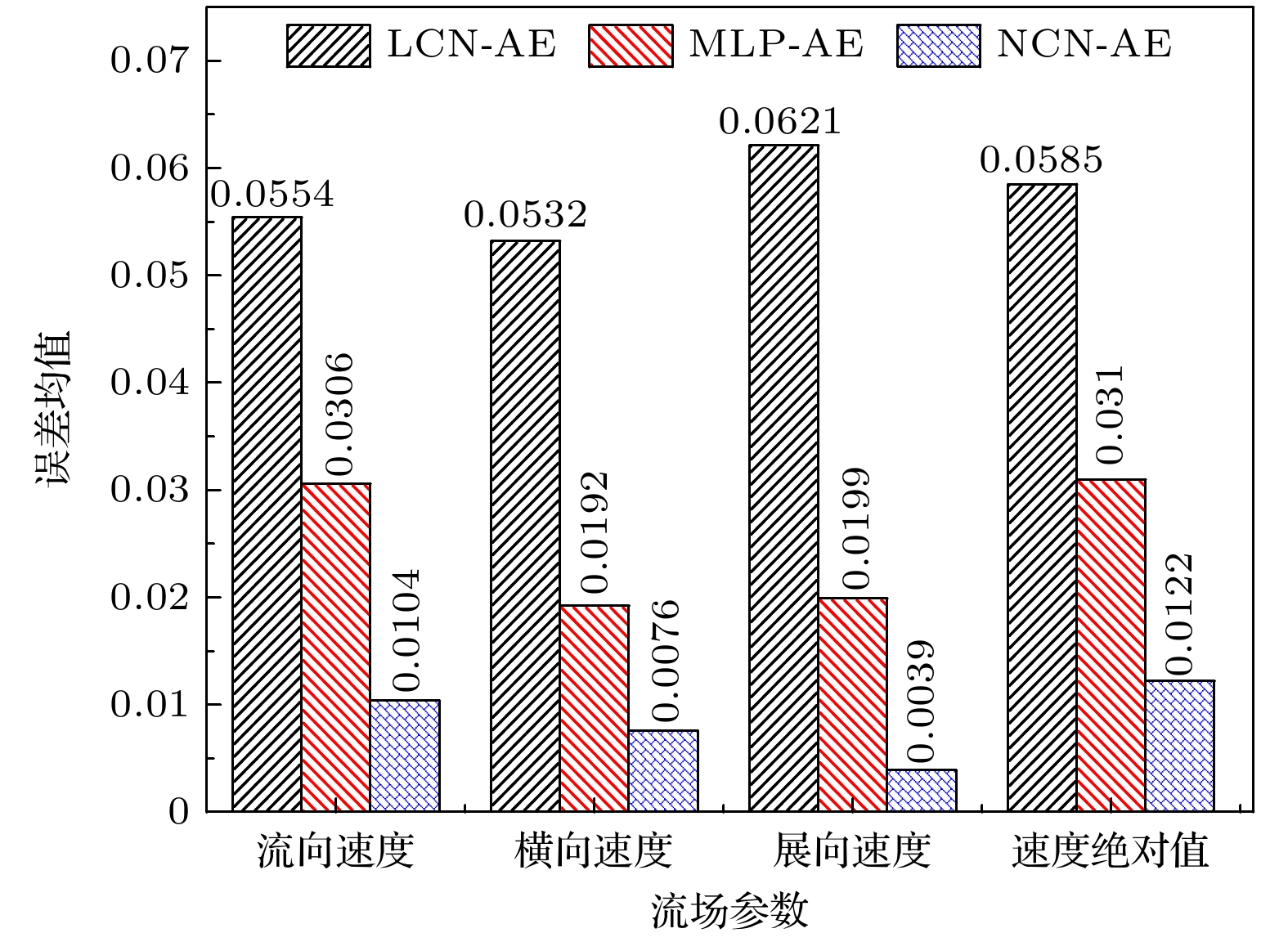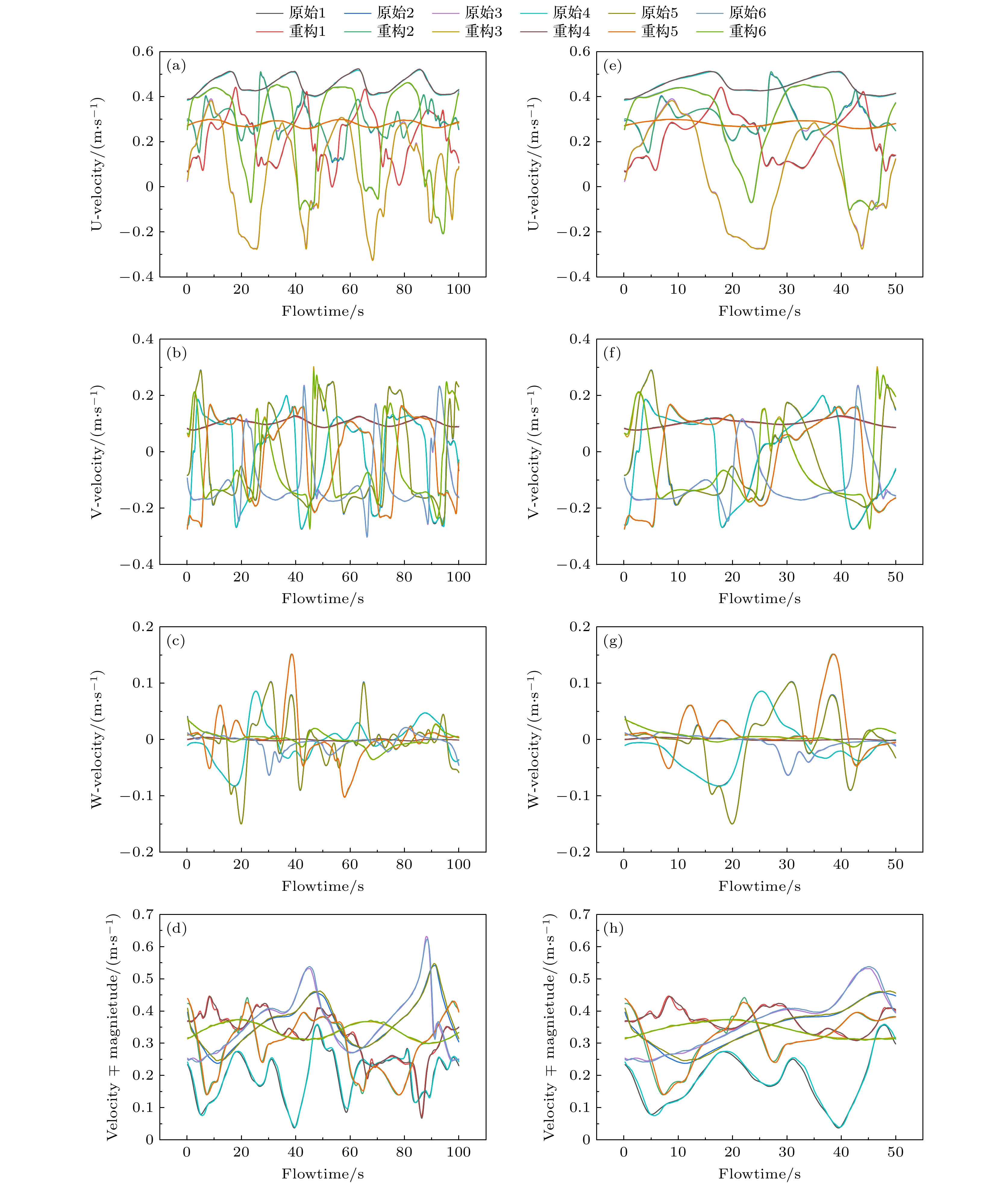-
流场的特征分析与表征研究对流动机理的明确具有重要意义. 然而湍流流场具有复杂的非定常时空演化特征, 对其流场数据的低维表征有一定困难. 针对此问题, 本文提出了基于流场时程数据深度学习方法的湍流低维表征模型, 实现了复杂流动数据的降维表征. 分别建立了基于一维线性卷积、非线性全连接和非线性卷积的自动编码方法, 对非定常时程数据进行降维并得到了低维空间到时域的解码映射关系, 实现了特征提取与压缩. 通过Re = 2.2×104的方柱绕流场进行了研究与验证, 结果表明: 时程深度学习方法可以有效地实现流场的低维表征, 适用于复杂湍流问题; 非线性一维卷积自编码器对复杂流场的表征准确性优于全连接和线性卷积方法. 本文方法是无监督训练方法, 可应用于基于一点的传感器数据处理中, 是研究复杂流场特征的新方法.Flow analysis and low-dimensional representation model is of great significance in studying the complex flow mechanism. However, the turbulent flow field has complex and unstable spatiotemporal evolution feature, and it is difficult to establish the low-dimensional representation model for the flow big data. A low-dimensional representation model of complex flow is proposed and verified based on the flow time-history deep learning method. One-dimensional linear convolution, nonlinear full connection and nonlinear convolution autoencoding methods are established to reduce the dimension of unsteady flow time history data. The decoding mapping from low-dimensional space to time domain is obtained to build the representation model for turbulence. The proposed method is verified by using flow around the square clyinder with Re = 2.2×104. The results show that the flow time-history deep learning method can be used to effectively realize the low-dimensional representation of the flow and is suitable for solving the complex turbulent flow problems; the nonlinear one-dimensional convolutional autoencoder is superior to the full connection and linear convolution methods in representing the complex flow features. The method in this work is an unsupervised training method, which can be widely used in single-point-based sensor data processing, and is a new method to study the characteristics of turbulence and complex flow problems.
-
Keywords:
- time-history deep learning /
- dimensionality reduction of flow data /
- convolution neural network /
- turbulent flow field /
- flow representation
[1] Berkooz G, Holmes P, Lumley J L 1993 Annu. Rev. Fluid Mech. 25 539
 Google Scholar
Google Scholar
[2] Sirovich L 1987 Q. Appl. Math. 45 561
 Google Scholar
Google Scholar
[3] Schmid P J, Sesterhenn J 2010 J. Fluid Mech. 656 5
 Google Scholar
Google Scholar
[4] Clarence W R, Igor M, Shervin B, Philipp S, Dan S H 2009 J. Fluid Mech. 641 115
 Google Scholar
Google Scholar
[5] 金晓威, 赖马树金, 李惠 2021 力学学报 53 2616
 Google Scholar
Google Scholar
Jin X W, Lai M S J, Li H 2021 Chin. J. Theor. Appl. Mech. 53 2616
 Google Scholar
Google Scholar
[6] Ling J, Kurzawski A, Templeton J 2016 J. Fluid Mech. 807 155
 Google Scholar
Google Scholar
[7] Li B, Yang Z, Zhang X, He G, Shen L 2020 J. Fluid Mech. 905 A10
 Google Scholar
Google Scholar
[8] Raissi M, Karniadakis G E 2018 J. Comput. Phys. 357 125
 Google Scholar
Google Scholar
[9] Kim H, Kim J, Won S, Lee C 2021 J. Fluid Mech. 910 A29
 Google Scholar
Google Scholar
[10] Murata T, Fukami K, Fukagata K 2020 J. Fluid Mech. 882 A13
 Google Scholar
Google Scholar
[11] Omata N, Shirayama S 2019 AIP Adv. 9 015006
 Google Scholar
Google Scholar
[12] Fukami K, Fukagata K, Taira K 2021 J. Fluid Mech. 909 A9
 Google Scholar
Google Scholar
[13] Liu B, Tang J, Huang H B, Lu X Y 2020 Phys. Fluids 32 025105
 Google Scholar
Google Scholar
[14] Callaham J, Maeda K, Brunton S L 2019 Phys. Rev. Fluids 4 103907
 Google Scholar
Google Scholar
[15] Fukami K, Maulik R, Ramachandra N, Fukagata K, Taira K 2021 Nat. Mach. Intell. 3 945
 Google Scholar
Google Scholar
[16] Erichson N B, Mathelin L, Yao Z W, Brunton S L, Maboney M W, Kutz J N 2020 Proc. R. Soc. A: Math. Phys. Eng. Sci. 476 20200097
 Google Scholar
Google Scholar
[17] Deng Z W, Chen Y J, Liu Y Z, Kim K C 2019 Phys. Fluids 31 075108
 Google Scholar
Google Scholar
[18] Han R K, Wang Y X, Zhang Y, Chen C 2019 Phys. Fluids 31 127101
 Google Scholar
Google Scholar
[19] Fukami K, Fukagata K, Taira K 2020 Theor. Comput. Fluid Dyn. 34 497
 Google Scholar
Google Scholar
[20] 战庆亮, 白春锦, 葛耀君 2022 力学学报 54 822
 Google Scholar
Google Scholar
Zhan Q L, Bai C J, Ge Y J 2022 Chin. J. Theor. Appl. Mech. 54 822
 Google Scholar
Google Scholar
[21] 战庆亮, 白春锦, 张宁, 葛耀君 2022 航空学报 43 126531
 Google Scholar
Google Scholar
Zhan Q L, Bai C J, Zhang N, Ge Y J 2022 Acta Aeronaut. Astronaut. Sin. 43 126531
 Google Scholar
Google Scholar
[22] 战庆亮, 葛耀君, 白春锦 2022 71 074701
 Google Scholar
Google Scholar
Zhan Q L, Ge Y J, Bai C J 2022 Acta Phys. Sin. 71 074701
 Google Scholar
Google Scholar
[23] 战庆亮, 周志勇, 葛耀君 2015 哈尔滨工业大学学报 47 75
 Google Scholar
Google Scholar
Zhan Q L, Zhou Z Y, Ge Y J 2015 J. Harbin Inst. Technol. 47 75
 Google Scholar
Google Scholar
-
图 3 数值模拟结果 (a) 升力与阻力系数; (b) z = 0切面瞬时速度矢量图; (c) y = 0切面瞬时速度矢量图; (d) x = 2切面瞬时速度矢量图
Fig. 3. Partial results of simulation: (a) Lift and drag coefficient; (b) sectional instantaneous velocity vector diagram at z = 0; (c) sectional instantaneous velocity vector diagram at y = 0; (d) sectional instantaneous velocity vector diagram at x = 2.
图 11 原始时程与重构时程的比较 (a) 流向速度; (b) 横向速度; (c) 展向速度; (d) 速度绝对值; (e) 流向速度的局部视图; (f) 横向速度的局部视图; (g) 展向速度的局部视图; (h) 速度绝对值的局部视图
Fig. 11. Comparision of original and reconstructed flow time history samples: (a) Flow velocity; (b) lateral velocity; (c) spanwise velocity; (d) absolute value of velocity; (e) partial view of flow velocity; (f) partial view of lateral velocity; (g) partial view of spanwise velocity; (h) partial view of absolute value of velocity.
表 1 非线性卷积自动编码模型参数
Table 1. NCN-AE model parameters.
名称 滤波器个数 非线性激活方法 Input — — Conv 1 64 ReLU Conv 2 32 ReLU Conv 3 20 ReLU Flatten layer — — Dense layer 20 ReLU Code layer 20 ReLU Dense layer2 20000 Reshape layer — — Conv_T 1 20 ReLU Conv_T 2 32 ReLU Conv_T 3 64 ReLU Output 1 ReLU 表 2 全连接自动编码模型参数
Table 2. MLP-AE model parameters.
名称 神经元数 非线性激活方法 Input — — Dense 1 64 ReLU Dense 2 32 ReLU Dense 3 20 ReLU Flatten layer — — Dense layer 20 ReLU Code layer 20 ReLU Dense layer2 20000 Reshape layer — — Dense 1 20 ReLU Dense 2 32 ReLU Dense 3 64 ReLU Output 1 ReLU 表 3 不同模型的误差散点图均值
Table 3. Mean relatively error of different models.
流场参数 LCN-AE MLP-AE NCN-AE 流向速度 0.0554 0.0306 0.0104 横向速度 0.0532 0.0192 0.0076 展向速度 0.0621 0.0199 0.0039 速度绝对值 0.0585 0.0310 0.0122 -
[1] Berkooz G, Holmes P, Lumley J L 1993 Annu. Rev. Fluid Mech. 25 539
 Google Scholar
Google Scholar
[2] Sirovich L 1987 Q. Appl. Math. 45 561
 Google Scholar
Google Scholar
[3] Schmid P J, Sesterhenn J 2010 J. Fluid Mech. 656 5
 Google Scholar
Google Scholar
[4] Clarence W R, Igor M, Shervin B, Philipp S, Dan S H 2009 J. Fluid Mech. 641 115
 Google Scholar
Google Scholar
[5] 金晓威, 赖马树金, 李惠 2021 力学学报 53 2616
 Google Scholar
Google Scholar
Jin X W, Lai M S J, Li H 2021 Chin. J. Theor. Appl. Mech. 53 2616
 Google Scholar
Google Scholar
[6] Ling J, Kurzawski A, Templeton J 2016 J. Fluid Mech. 807 155
 Google Scholar
Google Scholar
[7] Li B, Yang Z, Zhang X, He G, Shen L 2020 J. Fluid Mech. 905 A10
 Google Scholar
Google Scholar
[8] Raissi M, Karniadakis G E 2018 J. Comput. Phys. 357 125
 Google Scholar
Google Scholar
[9] Kim H, Kim J, Won S, Lee C 2021 J. Fluid Mech. 910 A29
 Google Scholar
Google Scholar
[10] Murata T, Fukami K, Fukagata K 2020 J. Fluid Mech. 882 A13
 Google Scholar
Google Scholar
[11] Omata N, Shirayama S 2019 AIP Adv. 9 015006
 Google Scholar
Google Scholar
[12] Fukami K, Fukagata K, Taira K 2021 J. Fluid Mech. 909 A9
 Google Scholar
Google Scholar
[13] Liu B, Tang J, Huang H B, Lu X Y 2020 Phys. Fluids 32 025105
 Google Scholar
Google Scholar
[14] Callaham J, Maeda K, Brunton S L 2019 Phys. Rev. Fluids 4 103907
 Google Scholar
Google Scholar
[15] Fukami K, Maulik R, Ramachandra N, Fukagata K, Taira K 2021 Nat. Mach. Intell. 3 945
 Google Scholar
Google Scholar
[16] Erichson N B, Mathelin L, Yao Z W, Brunton S L, Maboney M W, Kutz J N 2020 Proc. R. Soc. A: Math. Phys. Eng. Sci. 476 20200097
 Google Scholar
Google Scholar
[17] Deng Z W, Chen Y J, Liu Y Z, Kim K C 2019 Phys. Fluids 31 075108
 Google Scholar
Google Scholar
[18] Han R K, Wang Y X, Zhang Y, Chen C 2019 Phys. Fluids 31 127101
 Google Scholar
Google Scholar
[19] Fukami K, Fukagata K, Taira K 2020 Theor. Comput. Fluid Dyn. 34 497
 Google Scholar
Google Scholar
[20] 战庆亮, 白春锦, 葛耀君 2022 力学学报 54 822
 Google Scholar
Google Scholar
Zhan Q L, Bai C J, Ge Y J 2022 Chin. J. Theor. Appl. Mech. 54 822
 Google Scholar
Google Scholar
[21] 战庆亮, 白春锦, 张宁, 葛耀君 2022 航空学报 43 126531
 Google Scholar
Google Scholar
Zhan Q L, Bai C J, Zhang N, Ge Y J 2022 Acta Aeronaut. Astronaut. Sin. 43 126531
 Google Scholar
Google Scholar
[22] 战庆亮, 葛耀君, 白春锦 2022 71 074701
 Google Scholar
Google Scholar
Zhan Q L, Ge Y J, Bai C J 2022 Acta Phys. Sin. 71 074701
 Google Scholar
Google Scholar
[23] 战庆亮, 周志勇, 葛耀君 2015 哈尔滨工业大学学报 47 75
 Google Scholar
Google Scholar
Zhan Q L, Zhou Z Y, Ge Y J 2015 J. Harbin Inst. Technol. 47 75
 Google Scholar
Google Scholar
计量
- 文章访问数: 7751
- PDF下载量: 108
- 被引次数: 0














 下载:
下载:










